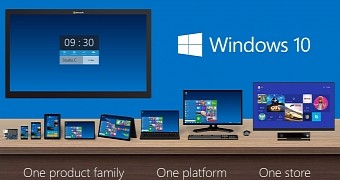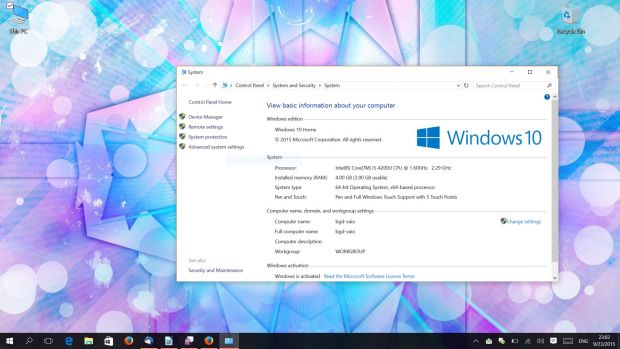Windows 10 was released on July 29 as a smooth upgrade for those running Windows 7 or 8.1 on their PCs, but contrary to everyone's expectations, the transition to the new operating system was actually a really bumpy adventure.
There were plenty of issues experienced by those who wanted to upgrade, but one of the most painful caused their systems to fail to activate after installing Windows 10 from scratch.
Microsoft offered what was supposed to be a really simple process to allow users to perform a clean install: first, they had to upgrade to Windows 10 using the built-in feature, regardless of whether they were running Windows 7 or 8.1. Once they installed Windows 10, the new OS activated automatically and allowed for a clean install using a key embedded in the system.
So basically, once users upgraded to Windows 10, they could perform a clean install without any issues, with re-activation to be performed automatically at the end of the process.
That didn't happen, however, and activation failed on plenty of systems due to what Microsoft called server overload. Thousands of users complained that Windows 10 couldn't be activated, and although all problems have since been solved, we're still hearing from some readers that activation is impossible after a clean install. Truth be told, we installed it and it worked just fine.
Then, there are the other million of issues experienced by people across the world, some of which prevented them from upgrading to Windows 10 with the built-in features.
Basically, there are a gazillion problems that a Windows 7 or 8.1 user might come across when trying to get Windows 10, and we experienced one of them when trying to upgrade a Sony VAIO.
The device came with Windows 8 pre-installed, and no updates had been performed in the last 2 years, so when we decided to upgrade to Windows 10, there were no more, no less than 121 updates that had to be installed. Almost 1 GB of updates plus more than 3GB of the Windows 8.1 update (Windows 10 requires Windows 8.1, so you can't upgrade directly from Windows 8).
4 days for the “smooth” upgrade
Our upgrade adventure can be resumed to just a few words: update, force reboot because of a system freeze, restart updates, reboot again because of the same freeze, try to install Windows 8.1 from the store, stuck at 82 percent, restart only important updates, reboot because of the same freeze, install Windows 8.1 with Bluetooth disabled (we heard that this could help), stuck at 82 percent, install updates one by one, force reboot because of system freeze.
Two days later, we were pretty much in the very same point, with our device still running Windows 8 and still unable to upgrade to Windows 10.
So we decided to get in touch with Microsoft Support. After 30 minutes of chatting and a remote control session, we're connected to a level 2 technician because, somehow, our problem needs a more in-depth look at system files.
If you've ever tried to contact Microsoft support, you probably know that it's all a big pain in the neck, so we ended up trying to fix the issue on our own. And we did manage to do that with the Media Creation Tool, a forced update to Windows 8.1, another gazillion of updates to prepare the system for Windows 10, and finally, the upgrade itself to Windows 10.
Four days later, we managed to get Windows 10 up and running.
Patience is a virtue
After so many days trying to install Windows 10, we can't help but wonder what can happen to someone with limited computer knowledge or someone who doesn't have the time or the patience to diagnose all these errors. We've received the answer from one of our readers: pirate Windows 10.
After trying to figure out the logic behind this reason, we got it. And he really does have a point here. Why try so hard when you can clean-install Windows 10 and use it in the worst possible way (for Microsoft)? Ignorance might actually hurt Windows 10.
As awful as it may sound for some, it's extremely easy to bypass Windows 10 activation and get a pirated copy running on your computer if you know where to look. Instructions on how to do that are so detailed that even your grandma can do it.
So basically, given all of the above, we have two categories of users who are experiencing issues with Windows 10: those who cannot activate the new OS and those who come across so many upgrade issues and don't want to clean-install because they're afraid they could lose their license.
In both cases, a clean install of Windows 10 that can fix any other time-wasting issue and a one-click method to bypass activation could become a solution, and by simply ignoring all problems experienced by its users, Microsoft might encourage more people to go in the wrong way.
Windows 10 needs everything to run smoothly, and after spending so much time trying to upgrade a device that's supposed to support the new OS in full, it's very clear that not everyone is willing to waste more than a couple of hours to install it.
So before anything, if Microsoft wants its users to go genuine, it must make it possible to install and activate Windows 10 legitimately. Otherwise, the number of users tempted to go in the opposite direction might be growing.

 14 DAY TRIAL //
14 DAY TRIAL // 

